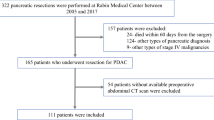Abstract
Background
Accurate prediction of survival from adrenocortical carcinoma (ACC) is difficult and current staging models are unreliable. Central sarcopenia as part of the cachexia syndrome is a marker of frailty and predicts mortality. This study seeks to confirm that psoas muscle density (PMD), lean psoas muscle area (LPMA), lumbar skeletal muscle index (LSMI), and intra-abdominal (IA) or subcutaneous fat (SC) can be used in combination to more accurately predict survival in ACC patients.
Methods
PMD, LPMA, IA, and SC fat were measured on serial CT scans of patients with ACC. Clinical outcome was correlated with quantitative data from patients with ACC and analyzed. A linear regression model was used to describe the relationship between PMD, LPMA, LSMI, IA, and SC fat, time to recurrence, and length of survival according to tumor stage.
Results
One hundred twenty-five ACC patients (94 females) were treated from 2005 to 2011. Significant morphometric predictors of survival include PMD, LPMA, and IA fat (p ≤ 0.0001, ≤0.0024, <0.0001, respectively) and improve prediction of survival compared to using stage alone. A 100-mm2 increase in LPMA confers an 8 % lower hazard of death. LSMI does not change significantly between stages (p = 0.3196).
Conclusion
Decreased PMD, LPMA, and increased IA fat suggest decreased survival in ACC patients and correlate with traditional staging systems. A more precise prediction of survival may be achieved when staging systems and morphometric measures are used in combination. Serial measurements of morphometric data are possible. The rate of change of these variables over time may be more important than the absolute value.



Similar content being viewed by others
References
Miller BS, Gauger PG, Hammer GD et al (2010) Proposal for modification of the ENSAT staging system for adrenocortical carcinoma using tumor grade. Langenbecks Arch Surg 395:955–961
Bilimoria KY, Shen WT, Elaraj D et al (2008) Adrenocortical carcinoma in the United States: treatment utilization and prognostic factors. Cancer 113:3130–3136
Sabolch A, Feng M, Griffith K et al (2011) Adjuvant and definitive radiotherapy for adrenocortical carcinoma. Int J Radiat Oncol Biol Phys 80:1477–1484
Polat B, Fassnacht M, Pfreundner L et al (2009) Radiotherapy in adrenocortical carcinoma. Cancer 115:2816–2823
Steensma DP, Loprinzi CL (2000) The art and science of prognosis in patients with advanced cancer. Eur J Cancer 36:2025–2027
Christakis NA, Lamont EB (2000) Extent and determinants of error in doctors’ prognoses in terminally ill patients: prospective cohort study. Br Med J 320:469–472
Lang T, Streeper T, Cawthon P et al (2010) Sarcopenia: etiology, clinical consequences, intervention, and assessment. Osteoporos Int 21:543–559
Tosteson AN, Gottlieb DJ, Radley DC et al (2007) Excess mortality following hip fracture: the role of underlying health status. Osteoporos Int 18:1463–1472
Longstreth WT Jr, Bernick C, Fitzpatrick A et al (2001) Frequency and predictors of stroke death in 5,888 participants in the Cardiovascular Health Study. Neurology 56:368–375
Englesbe MJ, Patel SP, He K et al (2010) Sarcopenia and mortality after liver transplantation. J Am Coll Surg 211:271–278
Lee JS, He K, Harbaugh CM et al (2011) Frailty, core muscle size, and mortality in patients undergoing open abdominal aortic aneurysm repair. J Vasc Surg 53:912–917
Fearon K, Strasser F, Anker SD et al (2011) Definition and classification of cancer cachexia: an international consensus. Lancet Oncol 12:489–495
Lughezzani G, Sun M, Perrotte P et al (2010) The European Network for the Study of Adernal Tumors is prognostically superior to the international union against cancer-staging system: a North American validation. Eur J Cancer 46:713–719
Miller BS, Ignatoski KM, Daignault S et al (2011) A quantitative tool to objectively assess degree of sarcopenia in patients with hypercortisolism. Surgery 150(6):1178–1185
Prado CM, Lieffers JR, McCargar LJ et al (2008) Prevalence and clinical implications of sarcopenic obesity in patients with solid tumours of the respiratory and gastrointestinal tracts: a population-based study. Lancet Oncol 9:629–635
Mourtzakis M, Prado CM, Lieffers JR et al (2008) A practical and precise approach to quantification of body composition in cancer patients using computed tomography images acquired during routine care. Appl Physiol Nutr Metab 33:997–1006
Prado CM, Birdsell LA, Baracos VE (2009) The emerging role of CT in assessing cancer cachexia. Curr Opin Support Palliat Care 3:269–275
Stephens NA, Skipworth RJ, Macdonald AJ et al (2011) Intramyocellular lipid droplets increase with progression of cachexia in cancer patients. J Cachexia Sarcopenia Muscle 2:111–117
Goodpaster BH, Kelley DE, Thaete FL et al (2000) Skeletal muscle attenuation determined by computed tomography is associated with skeletal muscle lipid content. J Appl Physiol 89:104–110
Prado CM, Baracos VE, McCargar LJ et al (2007) Body composition as an independent determinant of 5-fluorouracil-based chemotherapy toxicity. Clin Cancer Res 13:3264–3268
Andreyev HJ, Norman AR, Oates J et al (1998) Why do patients with weight loss have a worse outcome when undergoing chemotherapy for gastrointestinal malignancies? Eur J Cancer 34:503–509
Conflict of interest
The authors have no conflicts of interest to disclose.
Author information
Authors and Affiliations
Consortia
Corresponding author
Rights and permissions
About this article
Cite this article
Miller, B.S., Ignatoski, K.M., Daignault, S. et al. Worsening Central Sarcopenia and Increasing Intra-Abdominal Fat Correlate with Decreased Survival in Patients with Adrenocortical Carcinoma. World J Surg 36, 1509–1516 (2012). https://doi.org/10.1007/s00268-012-1581-5
Published:
Issue Date:
DOI: https://doi.org/10.1007/s00268-012-1581-5




